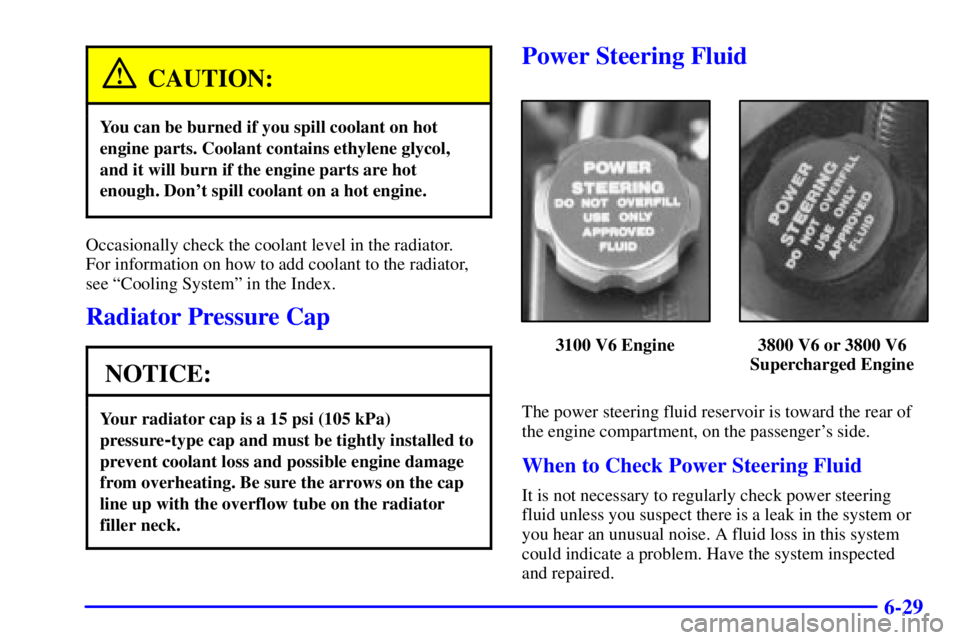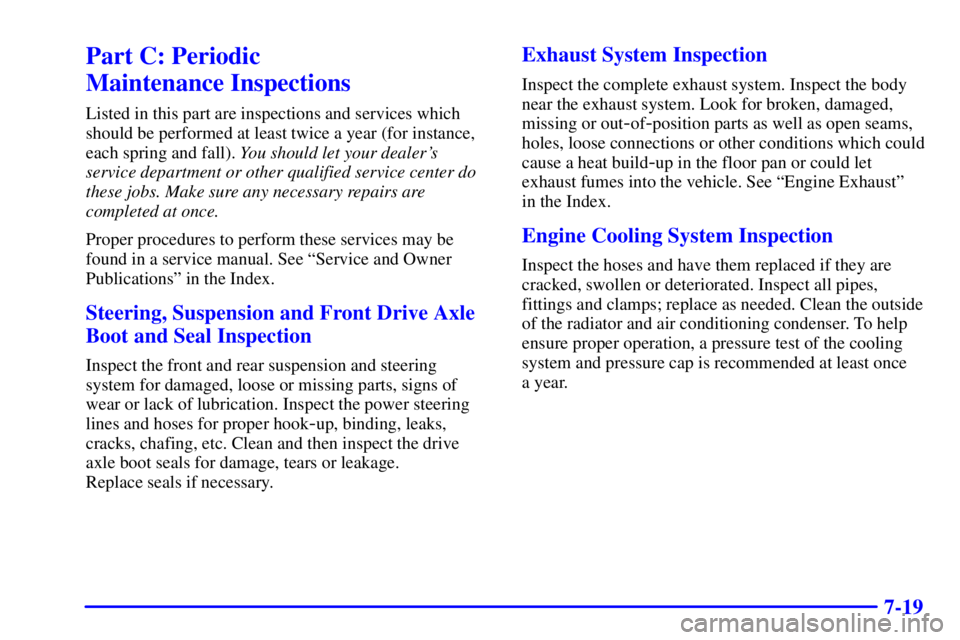Page 296 of 376

6-29
CAUTION:
You can be burned if you spill coolant on hot
engine parts. Coolant contains ethylene glycol,
and it will burn if the engine parts are hot
enough. Don't spill coolant on a hot engine.
Occasionally check the coolant level in the radiator.
For information on how to add coolant to the radiator,
see ªCooling Systemº in the Index.
Radiator Pressure Cap
NOTICE:
Your radiator cap is a 15 psi (105 kPa)
pressure
-type cap and must be tightly installed to
prevent coolant loss and possible engine damage
from overheating. Be sure the arrows on the cap
line up with the overflow tube on the radiator
filler neck.
Power Steering Fluid
3100 V6 Engine 3800 V6 or 3800 V6
Supercharged Engine
The power steering fluid reservoir is toward the rear of
the engine compartment, on the passenger's side.
When to Check Power Steering Fluid
It is not necessary to regularly check power steering
fluid unless you suspect there is a leak in the system or
you hear an unusual noise. A fluid loss in this system
could indicate a problem. Have the system inspected
and repaired.
Page 337 of 376

6-70
Radiator Cap
3100 V6 (Code J) AC Type RC27. . . . . . . . . . . . . . . .
3800 V6 (Code K) GM Part No. 10409635. . . . . . . . .
3800 V6 Supercharged (Code 1) GM Part . . . . . . . . .
No. 10409635
Spark Plugs
3100 V6 (Code J) AC Type 41
-940 . . . . . . . . . . . . . . .
Gap: 0.060 inches (.15 mm)
3800 V6 (Code K) AC Type 41
-921 . . . . . . . . . . . . . .
Gap: 0.060 inches (.15 mm)
3800 V6 Supercharged (Code 1) AC Type 41
-921 or
NGK Type PTR4B
-15
Gap: 0.060 inches (.15 mm)
Wiper Blades
Type Hook. . . . . . . . . . . . . . . . . . . . . . . . . . . . . . . . . .
Length 22 inches (55.9 cm). . . . . . . . . . . . . . . . . . . . .
Vehicle Dimensions
Wheelbase 110.5 inches (280.7 cm). . . . . . . . . . . . . .
Tread Width
Front 62.0 inches (157.5 cm). . . . . . . . . . . . . . . . . .
Rear 61.5 inches (156.1 cm). . . . . . . . . . . . . . . . . . .
Length 196.5 inches (499.1 cm). . . . . . . . . . . . . . . . .
Width 72.7 inches (184.5 cm). . . . . . . . . . . . . . . . . . .
Height 54.7 inches (139.0 cm). . . . . . . . . . . . . . . . . . .
Page 351 of 376

Scheduled Maintenance
7-14
100,000 Miles (166 000 km)
�Inspect spark plug wires.
An Emission Control Service.
�Replace spark plugs.
An Emission Control Service.
�Change automatic transaxle fluid and filter if the vehicle is mainly driven
under one or more of these conditions:
± In heavy city traffic where the outside temperature regularly reaches
90�F (32�C) or higher.
± In hilly or mountainous terrain.
± When doing frequent trailer towing.
± Uses such as found in taxi, police or delivery service.
�If you haven't used your vehicle under severe service conditions listed
previously and, therefore, haven't changed your automatic transaxle fluid,
change both the fluid and filter.
150,000 Miles (240 000 km)
�Drain, flush and refill cooling system (or every 60 months since last service,
whichever occurs first). See ªEngine Coolantº in the Index for what to use.
Inspect hoses. Clean radiator, condenser, pressure cap and neck. Pressure test
the cooling system and pressure cap.
An Emission Control Service.
ACTUAL
SERVICED BY:MILEAGE
DATE
ACTUAL
SERVICED BY:MILEAGE
DATE
Page 356 of 376

7-19
Part C: Periodic
Maintenance Inspections
Listed in this part are inspections and services which
should be performed at least twice a year (for instance,
each spring and fall). You should let your dealer's
service department or other qualified service center do
these jobs. Make sure any necessary repairs are
completed at once.
Proper procedures to perform these services may be
found in a service manual. See ªService and Owner
Publicationsº in the Index.
Steering, Suspension and Front Drive Axle
Boot and Seal Inspection
Inspect the front and rear suspension and steering
system for damaged, loose or missing parts, signs of
wear or lack of lubrication. Inspect the power steering
lines and hoses for proper hook
-up, binding, leaks,
cracks, chafing, etc. Clean and then inspect the drive
axle boot seals for damage, tears or leakage.
Replace seals if necessary.
Exhaust System Inspection
Inspect the complete exhaust system. Inspect the body
near the exhaust system. Look for broken, damaged,
missing or out
-of-position parts as well as open seams,
holes, loose connections or other conditions which could
cause a heat build
-up in the floor pan or could let
exhaust fumes into the vehicle. See ªEngine Exhaustº
in the Index.
Engine Cooling System Inspection
Inspect the hoses and have them replaced if they are
cracked, swollen or deteriorated. Inspect all pipes,
fittings and clamps; replace as needed. Clean the outside
of the radiator and air conditioning condenser. To help
ensure proper operation, a pressure test of the cooling
system and pressure cap is recommended at least once
a year.
Page:
< prev 1-8 9-16 17-24